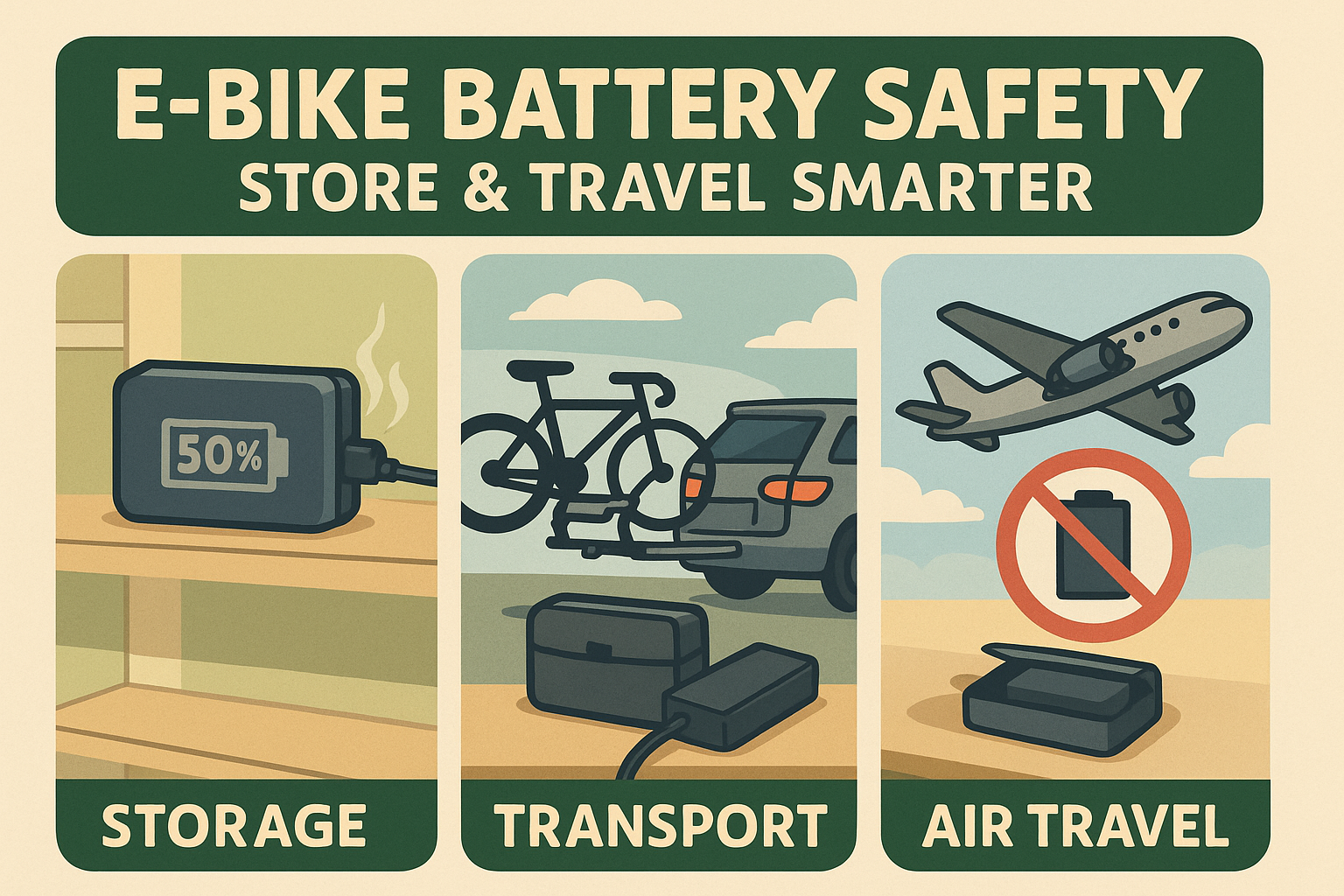Your e-bike battery is the most expensive single component of your bike, and protecting it is key to a long and happy riding life. But proper care isn't just about how you charge it—it’s also about how you store and transport it. Leaving a battery in the wrong state or environment can cause permanent damage, create a safety risk, and ultimately, cost you hundreds of dollars in a premature replacement.
This guide will walk you through the essential rules for safe storage and transport, from the "golden zone" for charge to the best way to travel with your e-bike.
Part 1: The Long-Term Storage “Golden Zone” (40–60% Rule)
Whether you’re storing your e-bike for the winter or simply taking a break from riding for a few weeks, how you leave your battery is critical. The goal is to put it in a stable, low-stress state.
The Myth: Store It at 100% or 0%
It’s tempting to either fully charge your battery so it’s ready to go or let it drain completely to "save" its life. Both of these are major mistakes.
- Storing at 100%: A fully charged lithium-ion battery is in a state of high-voltage stress. Leaving it in this state for weeks or months at a time accelerates its natural chemical degradation, leading to a permanent loss of capacity.
- Storing at 0%: Storing a battery completely empty is even more dangerous. The battery’s internal management system (BMS) still draws a tiny amount of power to function. If the voltage drops too low, it can enter a state of "deep discharge" from which it may be impossible to recover.
The Rule: Store It at 40-60%
For long-term storage, the ideal charge level is between 40% and 60%. This is the most relaxed and stable state for the battery’s chemistry, where degradation is at its slowest.
Your Action Plan: Before storing your e-bike for more than a few weeks, check the charge level. If it’s too high, take a short ride to drain it. If it’s too low, give it a quick top-up. Remove the battery from the bike and store it separately.
Part 2: Your Fire-Safe Storage Setup
A battery in a good state of charge is the first step; the second is a safe environment. While battery malfunctions are rare, taking a few simple precautions can provide peace of mind.
- Choose a Cool, Dry Place: Store your battery indoors in a climate-controlled environment, ideally between 10°C and 20°C (50°F and 68°F). Avoid garages or sheds where temperatures can fluctuate dramatically.
- Keep It Away From Flammables: Store the battery on a hard, non-combustible surface (like concrete or tile) and away from flammable materials such as paper, wood, or textiles.
- Consider a Fire-Safe Container: For an extra layer of protection, consider storing your battery in a fire-resistant bag or a specialized metal battery container. These products are designed to contain a thermal event and prevent a fire from spreading.
Part 3: Transportation Safety: On the Road and in the Air
Just as important as storage is how you travel with your e-bike and its battery.
On the Road (Car, Van, etc.)
- Remove the Battery: This is the golden rule of e-bike transport. Always remove the battery when putting your e-bike on a car rack.
-
- Reduce Weight: An e-bike battery can weigh 5-10 pounds or more, adding unnecessary stress to your bike rack and vehicle.
- Prevent Damage: Road vibrations, bumps, and wind can loosen the battery or cause damage to its casing and connections.
- Protect Against Theft: An exposed battery is an easy target for opportunistic thieves.
- Store It Safely Inside: Once removed, store the battery inside your vehicle in a secure, padded bag or box. Keep it out of direct sunlight and away from extreme heat, such as a hot trunk.
In the Air (Airports, Planes)
- The Rule: You cannot fly with a standard e-bike battery. The rules set by the FAA and IATA are very strict. Most airlines prohibit carrying any lithium-ion battery with a watt-hour (Wh) rating over 160 Wh—and with prior approval, only two of these larger batteries are allowed.
- The Reality: A typical e-bike battery has a rating between 300 Wh and 700 Wh, far exceeding these limits. Attempting to check a large e-bike battery can lead to it being confiscated and destroyed.
- The Exception: Some small, low-capacity "range extender" batteries fall within the 160 Wh limit and may be allowed on a plane as a carry-on, but you must check with your specific airline and get approval beforehand.
Conclusion: A Small Effort for a Big Payoff
Caring for your e-bike battery when it’s not in use is just as important as how you ride it. By adopting these simple, proactive habits—from using the 40–60% rule for storage to safely stowing the battery during transport—you are making a small effort that will protect your investment, ensure its longevity, and give you the peace of mind that your e-bike is ready for any adventure.


Share:
Rain, Humidity & Charging: IP Ratings and What’s Actually Safe
Red Flags to Never Ignore: Heat, Swelling, Odor—What to Do Next